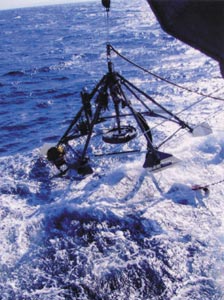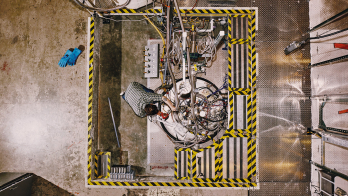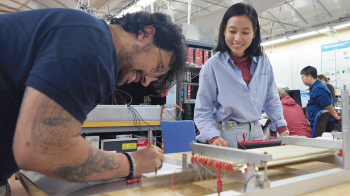On 29 March the NESTOR collaboration successfully deployed the first “floor” for a detector tower at its site 4000 m deep in the Ionian Sea. Data, including signals probably from downward-going muons, are being transmitted to the shore station in Methoni via a 30 km electro-optical cable laid on the sea-bed. This is the first time that continuous, real-time “physics” data have been obtained from such a depth, and represents a major step towards a kilometre cube neutrino detector.

The NESTOR (Neutrino Extended Submarine Telescope with Oceanographic Research) will ultimately consist of a tower with 12 floors of 32 m diameter, vertically spaced at 30 m. Each floor has 12, 38 cm diameter photomultiplier tubes (PMTs) mounted in pairs, looking upwards and downwards, at the ends of the six arms of a titanium “star”. The PMTs detect Cerenkov light radiated by muons produced by the interactions of high-energy neutrinos near the detector. The read-out and control electronics are housed in a titanium sphere at the star’s centre. With a total height of 410 m from the sea-bed, a tower will have an effective area of some 20,000 m2 to neutrinos at 10 TeV.
The deployment site off the south-west tip of mainland Greece (Peloponnese) is an underwater plateau 65 km2 in area at an average depth of 4000 m. This deep water, essential for a low cosmic muon background, is surprisingly close to shore, only 7.5 nautical miles (nm) from the island of Sapienza and 11 nm from Methoni. The NESTOR neutrino telescope is part of the scientific programme of the NESTOR Institute, in the town of Pylos on the bay of Navarino, 11 km north of Methoni.

The electro-optical cable from the shore station to the deep-sea site was laid in 2000. Then in January 2002 the end of the cable was brought to the surface by recovery buoy and connected to the junction box on the sea-bottom station, or “pyramid”. The pyramid also houses the sea electrode (the electrical power-return), the anchor system and environmental monitors. Bad weather made it dangerous to attach a detector floor on this occasion, but useful data were transmitted to shore from the pyramid during the descent, and long-term variations in environmental parameters were measured at the sea-bed. Since then, the team has been awaiting the availability of a suitable vessel and good weather.
Only in March this year could the pyramid be brought back to the surface and the floor deployed. The titanium sphere at the centre of the floor was connected to the junction box and the detector floor lowered into the sea, 80 m above the pyramid. The operation was quite fast and posed no problems. The junction box and sphere were powered and monitored from the shore station throughout the deployment. There are LED calibration pulse modules positioned above and below the floor and the assembly is kept vertical by a buoy.
The titanium sphere contains a “housekeeping” board for control and monitoring of all systems and a “floor board” that performs the PMT pulse sensing, majority logic event triggering, coincidence rate scaling, waveform capture and digitization, as well as the data formatting and transmission. Parameters and functions can be downloaded over the optical link. The heart of the system is the Analog Transient Waveform Digitizer (ATWD), developed at Lawrence Berkeley Laboratory. Each ATWD has four channels with 128 common-ramp, 10-bit Wilkinson ADCs, and a present sampling rate of 282 MHz. A trigger is generated when the coincidence requirement for the floor is met and provides a time stamp for combining information from several floors.
Reconstruction and calibration have only just started but the data already obtained look very good. The plots show a typical event, with evidence of a downward-going muon. Even with a single floor, it may be possible to reconstruct tracks near to the horizon.
To avoid future delays the Delta Verenike, a large, self-powered floating platform with GPS dynamic positioning, has been designed for the deployment of NESTOR. Funded from within the Institute’s infrastructure budget, construction is well advanced and delivery is expected later this year.
Further reading
For more details about the NESTOR Institute and neutrino telescope, see www.nestor.org.gr.







